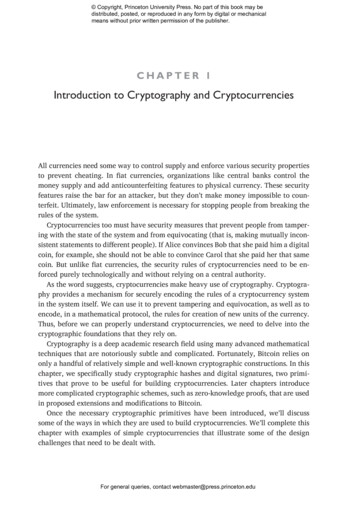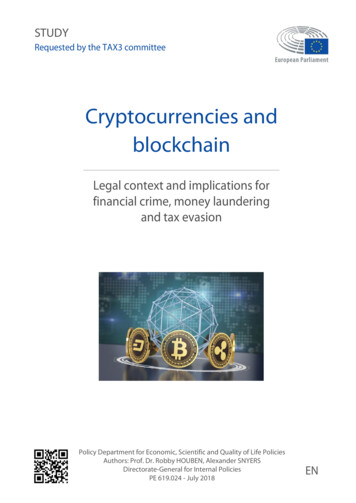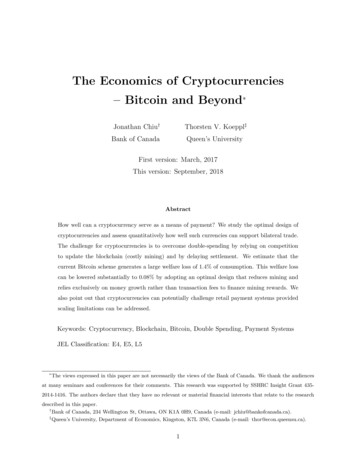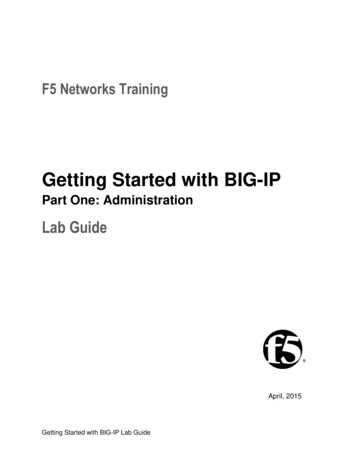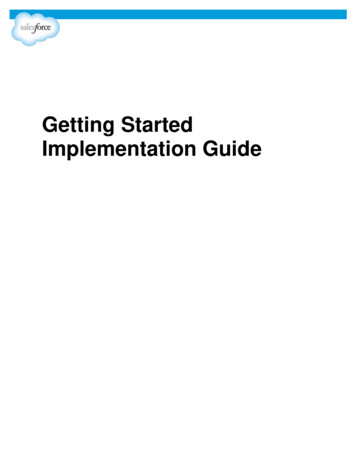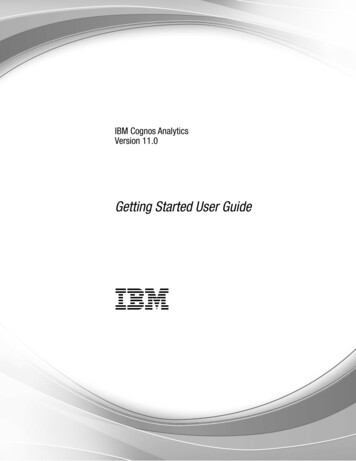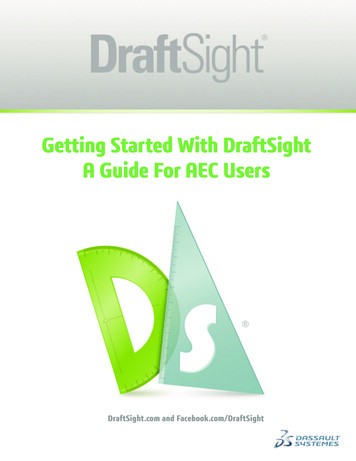
Transcription
Cryptocurrencies:A Guide to Getting StartedGlobal Future Council onCryptocurrenciesCOMMUNIT Y PAPERJUNE 2021
Cover: Unsplash/EfeKurnazInside: Unsplash/CallumWale; Unsplash/KrzysztofKowalik; Unsplash/NaomiHutchinson;Unsplash/JosueAs; Unsplash/RalphRavi; Unsplash/ChristianLue;Contents3Executive summary4561 Getting started1.1 Buying cryptocurrency1.2 Making transactions788899112 Exploring the blockchain2.1 Block explorer2.2 Pseudonymity vs anonymity2.3 Privacy2.4 Running a node2.5 Consensus mechanisms and mining2.6 Energy consumption1213133 Programmability3.1 Ethereum3.2 Languages and reference implementations144 Governance165 Throughput and scalability186 Compliance and regulatory considerations207 Conclusion21Contributors22Endnotes 2021 World Economic Forum. All rightsreserved. No part of this publication maybe reproduced or transmitted in any formor by any means, including photocopyingand recording, or by any informationstorage and retrieval system.Cryptocurrencies: A Guide to Getting Started2
June 2021Cryptocurrencies: A Guide to Getting StartedExecutive summaryAs cryptocurrencies transform how we trade,transact and interact online, it has becomemore important than ever for technology leadersto have experience with these innovations.Since the creation of bitcoin in 2008,cryptocurrencies have been the subject ofuncertainty, scepticism, hype and disillusionment.While still early as a technology category,cryptocurrencies are now maturing andhave demonstrable utility.1 As of this writing,cryptocurrencies in aggregate are valued at over 2 trillion in market capitalization.2 Cryptocurrencybased lending applications and decentralizedtrading venues currently command 65 billion inon-boarded assets.3 Just in the first quarter of2021, over 1 billion worth of digital collectiblesand digital art traded hands, underpinned bycryptocurrency networks.4 This is not to mentionthe areas that are still in exploratory phases:community governance, file storage, and crossborder payments, among others.As cryptocurrency matures, there has beenincreased interest from technology leadersin understanding this industry. While there isno shortage of content that exists explainingcryptocurrency technology and the promise that itholds, there is little reliable, practical guidance onwhere and how technology professionals can getstarted with getting hands-on with cryptocurrency.This guide serves as a manual for corporateleaders, including, but not limited to, chiefexecutive officers, innovation officers, chiefinformation officers, product managers and othertechnology professionals. You should come awaywith an understanding of how to transact andtrade cryptocurrencies, view and participate inthe underlying blockchain systems, get startedprogramming decentralized applications, engagein blockchain governance systems, reason aboutboth privacy and scalability trade-offs amongdifferent cryptocurrencies, and research andconsider relevant jurisdictional guidelines andregulations. The best way to be equipped to speakto, engage with and apply cryptocurrency to yourlife and your workplace is not to read about it, butrather to start working with it directly. The contentsof this manual are your guide for doing so.Note about scope: This guide speaks strictlyto cryptocurrency – digital assets and digitalinfrastructure such as Bitcoin and Ethereum – thatare open sourced and public. It does not addressprivate or permissioned blockchains, or their relateddigital assets.Cryptocurrencies: A Guide to Getting Started3
1Getting startedCryptocurrencies: A Guide to Getting Started4
1.1 Buying cryptocurrencyMany institutionschoose to relyon third parties,either exchangesor dedicatedcustodians, inorder to hold theircryptocurrencyassets.As you start your journey, you may be interestedin acquiring cryptocurrency. We will walk througha few basic steps to follow in order to do this afterconsidering the legality of cryptocurrency inyour jurisdiction:Custody cryptocurrencyTo own cryptocurrency, you are required to have a“wallet”. A cryptocurrency wallet is how coins andtokens are held or custodied.There are a couple of options for “custody” of yourassets:––Third-party service: You may choose to holdyour cryptocurrency with a third party, such asan exchange, which will provide the wallet foryou. In this case, you should be aware that youare trusting the security of that exchange withyour assets. If the exchange gets hacked, youmay have little or no recourse. Generally, to setup a wallet with an exchange, you will need toset up an account using information, includingyour name, passport or ID number.Self-hosted: You may choose to self-host yourwallet. If you go this route, you will bypassthese identification requirements of third-partyproviders. You will also be taking the security ofyour assets into your own hands. Be aware thatif you lose the necessary materials to accessyour wallet, you will have no recourse.The type of cryptocurrency wallet that you willwant will depend on the specific needs andfeatures desired. Some cryptocurrency wallets onlysupport specific cryptocurrencies or have limitedfunctionality. This can sometimes mean a trade-offbetween security and usability. Major differencesrelated to the custody of cryptocurrency includewho has access to the private keys of the wallet,how often sensitive data is exposed to the internet,and the type of software or hardware that can beused in setup and maintenance.Many institutions choose to rely on third parties,either exchanges or dedicated custodians, inorder to hold their cryptocurrency assets. Thisgives them comfort that the ultimate responsibilityaround the security of their assets lies with a thirdparty. However, this entails deep due diligence tounderstand the reliability, reputation and recourseprovided by that exchange or custodian. Otherinstitutions, particularly those with the requisitesecurity know-how in-house, choose to self-host.apps or desktop applications (typically considered“hot” wallets as they are regularly connected to theinternet) or on a specialized, separate hardwaredevice not connected to the internet (also referredto as “cold” storage). There is also the possibility touse a multi-signature wallet, which requires multipleprivate keys to approve a transaction before assetsare transferred (an m of n setup). In theory, this canincrease the security of funds. There are pros andcons to each type of wallet with differing security,recovery methods and usability.5Determine a method to acquire cryptocurrencyOnce you have a wallet established, or a way tocustody your assets, you will need to acquire yourcryptocurrency. There are several methods andplatforms to consider:–Purchasing cryptocurrency as an individual:The most common route is to buy it via acentralized exchange.6 These exchanges serveas on- and off-ramps and charge fees (rangingfrom roughly 0.05-5.00%) on each transaction.Different jurisdictions have different exchangesproviding liquidity.–Purchasing cryptocurrency as an institution:You can use a centralized exchange, but oftenbetter liquidity and lower fees will be foundvia an over-the-counter trading desk. You cansearch for the competitors in these marketsbased on your jurisdiction.–Alternative methods: Buying cryptocurrencyis not the only way to own cryptocurrency.Other ways to acquire cryptocurrency includeparticipation in the network (mining and staking),earning it (payment for work), airdrops (coinsand tokens are randomly distributed to wallets),faucets (a way to collect small quantities ofcrypto for free), and more.TaxationEach country taxes digital assets, includingcryptocurrency, differently. Keep track of allcryptocurrency transactions to simplify yourreconciliation process (when was the transfer made,in what amount, for what goods or services, etc.).Keep in mind that converting one cryptocurrencyto another cryptocurrency (e.g. bitcoin to ether)may be considered taxable in some jurisdictions.Spending cryptocurrency to purchase small-valueobjects such as a coffee may also be taxable as itconstitutes a sale of the cryptocurrency.Custodying cryptocurrency is really about thesecure custody of a private key, or a string ofdata akin to a password. Private keys may berepresented as a binary code, QR code, mnemonicphrase or other formats. Private keys may bestored in software applications such as mobileCryptocurrencies: A Guide to Getting Started5
1.2 Making transactionsTo make a transaction, you will need a few piecesof information. You will need access to yourcryptocurrency. This involves having the informationneeded to access your funds via the third-partycustodian, or having the private key to access thefunds in your self-hosted wallet. You will also need thewallet address (or public key) of your counterparty.This might take the form of a string or QR code.Once you enter the amount you are sending andthe address of your counterparty, the system willsign your transaction with your private key (eitherdone by you personally, or by the third party if youchose to use one), broadcast this to the networkand show a unique code that represents thetransaction called the transaction hash.Cryptocurrencies: A Guide to Getting Started6
2Exploring the blockchainCryptocurrencies: A Guide to Getting Started7
2.1 Block explorerA block explorer – a website that tracks all theinformation inside the blockchain and shows it inintelligible form – is a useful tool for any blockchainuser. It acts as a “search engine” for a particularblockchain, allowing users to verify transactions, orcheck the status of the network.Most blockchains are transparent, meaning alldetails of each transaction are publicly broadcastedand recorded and allow for associated metadatato be queried via a block explorer. Traders canverify that transactions have gone through andfinalized, agencies can audit and verify reporteddata, and law enforcement can trace the movementof funds. Individuals can also use block explorersto better understand the degree to which and howblockchains are being used.2.2 Pseudonymity vs anonymityMost blockchains enable pseudonymity, but notanonymity, meaning they do not guarantee that auser will be unidentifiable.Pseudonymity means that identities on theblockchain are not directly linked to real-worldidentifiers such as names, addresses, oridentification numbers. When looking at a blockexplorer, you will not see names of individuals orinstitutions, but rather strings of data representingthose holders’ public key addresses. With enougheffort, however, most of those addresses canbe linked back to identifiers. This can be donevia examination of on-chain activity, transactionhistories and trails, and analysis of other data suchas timestamps and IP addresses associated withtransactions.2.3 PrivacyThere are,however, a handfulof privacy coinsthat enableprivate blockchaintransactions.As discussed earlier, most blockchains storedata in a way that is publicly accessible at anytime. There are, however, a handful of privacycoins that enable private blockchain transactions.Two of the best-known projects focusing on thisuse case are Monero (XMR) and Zcash (ZEC), afork of the Bitcoin protocol that leverages ZeroKnowledge Proofs (ZKPs) to maintain privacy. Thebasic idea behind ZKPs consists in allowing oneparty (a prover) to prove to another one (a verifier)the possession of a certain information withoutrevealing that information.Zcash incorporates transparent “t” and private “z”addresses for sending, receiving, and storing ZEC,thus offering four transaction types from whichthe user can choose. For example, a transactionfacilitated between two “z” addresses is fullyshielded. This implies only the fees paid and theoccurrence of the transaction appear on the publicblockchain, while the addresses, transaction amountand the encrypted memo field are not publicly visible.For auditing and regulatory compliance, Zcash userscan use view keys to selectively share address andtransaction information.Monero, on the other hand, only offers fully privatetransactions. The Monero protocol maintains theprivacy of its senders through ring signatures,which do not require a trusted party to performa setup process. Ring signatures leverageprivate spend and view keys, as well as publicaddresses, to facilitate transactions while making itcomputationally impossible to determine whose keywas used to sign. Additionally, stealth addressesguarantee the wallet address of the recipientis never publicly linked to any transaction. Thepublic can nonetheless confirm the legitimacyof the transactions without de-anonymizing theparticipants through ring confidential transactions.Such privacy coins may face certain liquiditychallenges because the current regulatory view onthis feature is mixed, thus complicating their listingson exchanges.7Cryptocurrencies: A Guide to Getting Started8
2.4 Running a nodeFull nodes forany blockchainwill place highdemands onmemory, storageand bandwidth.Blockchains are decentralized, distributeddatabases. These databases are implemented insoftware and run on a network of nodes. Becausecryptocurrency blockchains are permissionless andthe code for popular nodes is open source, anyonecan participate in the network by running a node.Reasons for running a node may include:–Providing a service to the blockchain network:Nodes receive transactions, check them againstthe rules of the protocol and relay them on toother nodes. A diverse and resilient set of nodes isintegral to the health and security of the network.–Benefits to the host: Running a node enables theindividual or institution to interact directly withthe blockchain database without relying on thirdparties. This may be of particular importance tothose who place special value on privacy andsecurity or developers building wallets, blockexplorers and working on chain analytics.Running a full node entails downloading, validating,and hosting a full copy of the blockchain databaseof transactions, going back to the first transactionon the network. Archive nodes take this one stepfurther, maintaining a full memory of the state ofthe blockchain for any given point in time. Lightnodes, meanwhile, just store block headers, orabridged versions of the transactions in the chain.Light nodes are therefore reliant on full nodes formost data, but that data can be verified against theinformation contained in the block headers.There are costs to running nodes. Full nodes for anyblockchain will place high demands on memory,storage and bandwidth. All of this can becomecostly. Nodes generally need to be running for aminimum of six hours per day – and may take daysto sync the entire history of the blockchain for the firsttime. The Bitcoin blockchain demands a minimumof 350 gigabytes of free disk space, 2 gigabytes ofmemory, and a broadband internet connection withan upload speed of at least 400 kilobits per second.Light nodes make fewer demands on memory anddisk space (and can even be run on mobile phones)but are more reliant on network bandwidth.To judge whether running a full or a light node maybe of interest and in order to explore the first stepsin doing so, consult the following resources:–Bitcoin– Minimum requirements of a Bitcoin node– Bitcoin core–Ethereum– Benefits of an Ethereum node– Light client– How to set up an Ethereum nodeThere are also third-party providers who offer nodehosting services. This may be a more suitable pathif you are with an institution, such as a financialinstitution, that does not have particular sensitivitiesaround self-hosting and will not be developingapplications, or tools that need to directly interactwith the blockchain.2.5 Consensus mechanisms and miningConsensus mechanisms are a critical functionthat secure permissionless blockchain ledgersand enable the characteristics of immutability andcensorship resistance.Proof of Work (PoW), the mechanism for Bitcoin,is perhaps the best known. PoW mining is theprocess of computers competing for a rewardby executing a cryptographic mining algorithm tomeet an output of a predetermined difficulty level.Bitcoin miners hash four inputs using the SHA256 cryptographic hash function: the transactionsof a block; the hash of the previous block; thetime stamp; and the nonce (a random number).If the output of this cryptographic function meetsa certain difficulty level (i.e. a certain number ofleading zero bits), the block is accepted by othernodes on the network and the miner is rewarded.The culmination of mining results in the appendingof new blocks to the blockchain. The newlyappended blocks must adhere to the consensusrules of the Bitcoin network or will otherwise berejected by nodes. The costliness of PoW miningmeans those who mine bitcoin, but act against theconsensus rules of the network, lose significantsums of capital.A deeper dive– Difficulty: Because all miners are competingto append blocks to the Bitcoin network, thedifficulty rises as more miners join and dropsas miners fall. The difficulty adjusts every 2016blocks (or every two weeks) and this processkeeps miners finding blocks at a rate of roughlyone per 10 minutes.–Reward: When a block is successfullyappended, a miner can send the first transactionto their own address (known as the coinbasetransaction), which compensates the miner witha “block reward”. This block reward consistsCryptocurrencies: A Guide to Getting Started9
of newly issued bitcoin and all transaction feesfrom the mined block. The amount of newlyissued bitcoin halves every 210,000 blocks,approximately every four years. The blocksubsidy originally started at 50 bitcoin (BTC) andcurrently is at 6.25 BTC mined approximatelyevery 10 minutes, or about 900 bitcoin minedevery 24 hours (as of April 2021). This algorithmensures bitcoin is a scarce asset. Whenbitcoin first launched, for the first four years,approximately 7,200 bitcoin were mined daily.The key inputs tosuccessful miningare low powercost and accessto competitiveequipment.–Hashrate: The speed of solving thecryptographic hash function is the hashrate;the total amount is the network hashrate. Ifone miner controls around 10% of the Bitcoinnetwork hashrate, they can expect to mineroughly one in ten blocks, and more as theirshare of the network hashrate increases.Attacking the networkTo attack the network, a malicious entity wouldneed to capture 51% of the hash power, allowingthe entity to build a longer chain and doublespend bitcoin, which they had previously usedin a transaction. This would require convincingover 50% of miners to either sell or rent their hashpower or someone with more hash power than thecurrent total network hashrate.HardwareGiven the economic incentives, the mining industryis perpetually in an arms race to develop nextgeneration hardware that increases hashrateoutput. Early bitcoin miners started with centralprocessing units (CPUs), which evolved tographics processing units (GPUs) and then fieldprogrammable gate arrays (FPGAs). But in 2013,single-purpose application specific integratedcircuits (ASICs) optimized to hash the SHA-256algorithm became prevalent. The difficulty level ofbitcoin mining was pushed up significantly whenASICs were widely distributed to miners. Thehashrate performance of ASICs and consequentdifficulty jumps made all other hardware typesobsolete. Other types of hardware are still usedin the mining of other cryptocurrency protocols,especially those not based on SHA-256.The key inputs to successful mining are lowpower cost and access to competitive equipment(ASICs, servers). To build a business of size andscale, particularly for the most popular/competitivecryptocurrencies like bitcoin, miners take onsizable risk in the form of upfront investment andcapital expenditure in long-term power contracts,real estate, large volume mining equipment/ASICs,and energy efficient and temperature-controlleddata centres to host the mining equipment. Theupfront investment is often sized with certainassumptions about crypto market prices, whichcan be volatile and not guaranteed to materialize.Given the statistics of success, miners frequentlycollaborate through participation in a mining pool.Participating in a mining pool enables a minerto have certainty of bitcoin mining rewards on aconsistent schedule.Despite the investment risk and challengesassociated with industrial cryptocurrency mining,individuals can set up smaller scale miningoperations to participate fully in cryptocurrencynetworks and may even discover more productivityby mining less mainstream and less competitivecryptocurrencies.Getting started with PoW mining– Acquire equipment: Selection of equipmentdepends on the triangulation of cost,availability, hashrate performance and powerconsumption. You may choose either a bitcoinspecific ASIC or hardware that can be usedto mine multiple different cryptocurrencies,which have varying algorithms. While itmay be difficult to procure equipment frommanufacturers, there are secondary marketsfor used miners available for purchase. As themining hardware can be loud and hot, oftenrunning more than one miner may requirefinding a data centre hosting location witha low cost of power – factors include thelocation, source of power (renewable energybased), cost per kilowatt (kWh), as well aswhether or not the facility incurs additionalcosts like cooling requirements to ensuremaximum efficiency of the miners.–Select and contribute hashrate to mining pool:Once the hardware is set up, this can behelpful to ensure consistent returns. Factors toselecting a mining pool include cryptocurrencyspecialization, reputation, size of the pool andits overall percentage of global hashrate, feespaid to the pool and minimum payout sizes.For alternative coins seeking a less power-intensiveapproach to securing the network than PoWmining, various consensus models have emergedsuch as Ethereum’s move to Proof of Stake (PoS)and Algorand’s Pure Proof of Stake (PPoS), whichrequire miners to stake their native coins to becomenetwork validators, ordering transactions andcreating new blocks driving all nodes to agreementon the state of the network.In addition to less power usage, proponents forPoS suggest that barriers to entry are lower asspecialized equipment is not required to minesuccessfully and as more network participants areable to mine with general hardware, the networkcomposition may be more decentralized as well.However, there is some suggestion that PoS maylead to network mining inequality and may unfairlybenefit well-resourced network participants sinceCryptocurrencies: A Guide to Getting Started10
their ability to mine successfully is directly relatedto the amount of native coin owned. PPoS seeksto address both PoW’s energy consumptionand PoS’s miner inequity by enabling all networkparticipants the opportunity to propose andvalidate blocks (with only the probability of miningsuccessfully directly related to the amount ofnative coin owned). In selecting the consensusmechanism and mining protocol, cryptocurrencynetworks must trade-off between decentralization,scale and network security.For more information on the evolution of mining andhow to get started, visit:–––––––Evolution of Mining by Marshall Long, Tales fromthe CryptBeginner’s Guide to Mining, MasterDCChoosing a Mining Pool, Make Tech EasierGetting Started with Mining, Compass MiningGlobal Hash Rate, BTC.comMempool & Transaction Fees, Mempool.SpaceHow Blockchain Works, MIT2.6 Energy y andlatency while alsoreducing energyconsumption.As explained above, in order to participate inPoW, significant computational energy is required.Upfront capital expenditure and ongoing electricitybills are costs of running a node to participate inPoW networks (e.g. Bitcoin). Energy consumptiondepends on the difficulty of the cryptographicpuzzle to be solved by a mine in PoW. Nonetheless,the Cambridge Centre for Alternative Financeestimates bitcoin’s total electricity consumption tobe about 126.98 terawatt hours (TWh) per year.8The proof-of-work scheme is thus computeintensive and energy demanding, but it is keyto addressing the double-spending problemand ensuring the security of the blockchain, asit costs money to attack the network. It is hardto mitigate the energy consumption of PoWblockchains because even if more transactionsare added to one block, the cryptographic puzzledifficulty ultimately defines the amount of energyrequired to participate. In PoW blockchain, energyconsumption correlates to market capitalization.9Alternative consensus mechanisms such as PoSconsensus and permissioned blockchain consensusconsume less energy than PoW blockchains.10PoS blockchains are a good alternative to PoWblockchains and entail a participant “staking”capital. This consensus mechanism consumesmuch less energy and provides adequate security.However, PoS consensus is less battle-tested thanPoW so it cannot be said with full certainty thatthe PoS consensus provides the same securitylevel as PoW.11 Permissioned blockchain improvesefficiency and latency while also reducing energyconsumption. Permissioned blockchains areespecially suitable for public institutions aiming todecentralize some of their operations. However,they do not give the same flexibility when it comesto decentralization of participants.Thus, when a user is participating in a blockchainnetwork, they should assess what the economicbenefit is of choosing a specific type of consensusmechanism and ensure the energy consumption isweighed sufficiently against benefits.Cryptocurrencies: A Guide to Getting Started11
3ProgrammabilityCryptocurrencies: A Guide to Getting Started12
3.1 EthereumEthereum is thefirst, and mostwidely used,blockchain thatallows for thedevelopment ofprogrammableapplications.Ethereum is the first, and most widely used,blockchain that allows for the development ofprogrammable applications which operate on itsnetwork. It was inspired by Bitcoin and was publiclylaunched in 2016.There are a few key components to Ethereum andsimilar programmable blockchains:–––A smart contract is code on a blockchain thatexecutes when predefined conditions are met.For example, one could write a programmepermitting payment of 10 for a specific digitalaudio file, but only if transferred before a certaindate. Because this code is publicly auditable andverifiable, it allows strangers to have the trustto transact without the involvement of any thirdparties. Contrast that with today where a handfulof third parties operate behind the scenes: aplatform ensuring rights ownership, the bankensuring a buyer has funds and the databasewhich hosts the file.Solidity is Ethereum’s high-level programminglanguage for coding smart contracts, which arethen recorded and executed on the Ethereumblockchain.Ether (ETH) is the native currency used to payfor transaction fees. Running and verifyingsmart contracts requires energy and computingresources. ETH is the native token that paysnetwork nodes for their resource contributions(and therefore provides an incentive for othernodes to participate).–Decentralized applications (abbreviated as“dApps”), in turn, are programmes that useblockchain-based data and smart contracts,rather than centralized databases and computingenvironments.Therefore, what may sound like an arcane innovation –smart contracts recorded on a public ledger – has thepotential to enable entirely new ways of interacting onthe internet. For example, users can have full controlover their own data and use a smart contract to requirepayment for access to that data. This inverts ad-basedinternet monetization, where platforms sell user data toadvertisers and share little if any profit or control withusers. In addition, a blockchain is by nature a globallysynchronized database stored across many computersrather than servers owned by the few. This makes itmore difficult to curtail access or alter data according tonational origin or other motivations.Programmable blockchain infrastructure is an areaof robust technical innovation and competitionamong numerous protocols in an effort to increasethe speed, capacity and security of distributedinfrastructure to compete with the performance ofcentralized internet infrastructure.To get started with Ethereum, visit Ethereum.org.3.2 Languages and reference implementationsDifferent blockchains use unique languages andreference implementations – each with its own setof attacks and defences. Among the most commonlanguages used for blockchain are C , Solidity,Java, JavaScript and Python.Taking the example of the Ethereum blockchaindiscussed above, we will examine challenges, typesof languages and verifications. Exploitations emergewhen there is an error in the smart contract code;it arises when developers fail to identify code errorsin the decentralized application. Examples includere-entrancy, smart contract overflow/underflow,short address attack, delegate call, default visibilities,transaction ordering dependency and timestampdependence. The listed attacks can allow attackersto drain smart contracts or manipulate smart contractvulnerabilities to favour them.Defences have been made on Ethereum throughanalysis of smart contracts to mitigate attacks,including: Slither, a static analysis framework for smartcontract code; MythX, a security analysis service thatscans Ethereum Virtual Machine (EVM) based smartcontracts for vulnerabilities; and Mythril, a securitytool that analyses smart contracts written by Solidity.Various other types of smart contract languages havebeen created, such as Vyper, which was designedto be more simple, secure and easier to audit thanSolidity, Psamathe, Casper, Simplicity and IELE.Formal analysis and verification of compilers furtherassists resistance to attacks on Ethereum, done bygiving a formal model of the program-to-verify, eitherby a manual construction in a language which canbe interpreted by theorem provers such as Coq orIsabelle, or by a t
Apr 28, 2021 · regulations. The best way to be equipped to speak to, engage with and apply cryptocurrency to your life and your workplace is not to read about it, but rather to start working with it directly. The contents of this manual are your guide for doing so. Note about scope: This guide speaks strictly to cryptocurrency – digital assets and digital

